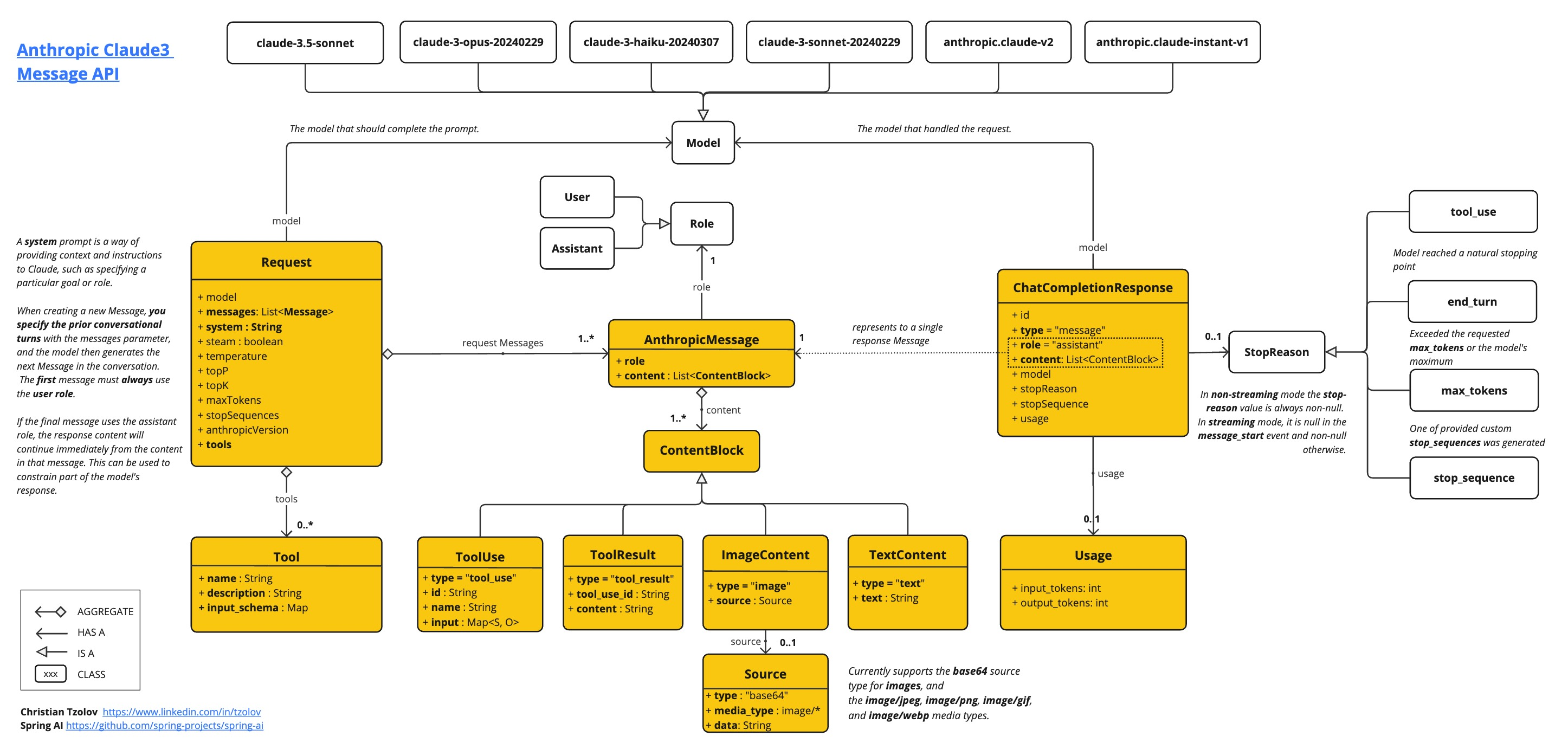Anthropic Chat
Anthropic Claude 是一系列可用于各种应用的基础 AI 模型。对于开发人员和企业,您可以利用 API 访问权限,直接在 Anthropic 的 AI 基础设施之上进行构建。
Spring AI 支持 Anthropic Claude API, 用于同步和流文本生成。
前提条件(Prerequisites)
您需要在 Anthropic 门户上创建一个 API 密钥。
在 Anthropic API 控制台中创建一个账户,并在 “获取 API 密钥” 页面上生成 API 密钥。
Spring AI 项目定义了一个名为 spring.ai.anthropic.api-key 的配置属性,你应该将其设置为从 anthropic.com 获取的 API Key 的值。
可以在 application.properties 文件中设置此配置属性:
spring.ai.anthropic.api-key=<your-anthropic-api-key>为了提高处理 API 密钥等敏感信息时的安全性,可以使用 Spring 表达式语言 (SpEL) 引用自定义环境变量:
# In application.yml
spring:
ai:
anthropic:
api-key: ${ANTHROPIC_API_KEY}您也可以在 application 代码中以编程方式获取这个配置:
// Retrieve API key from a secure source or environment variable
String apiKey = System.getenv("ANTHROPIC_API_KEY");添加存储库和 BOM
Spring AI 构件发布在 Maven Central 和 Spring Snapshot 存储库中。请参阅 Artifact 存储库部分,将这些存储库添加到构建系统中。
为了帮助进行依赖管理,Spring AI 提供了一个 BOM (材料清单), 以确保在整个项目中使用一致的 Spring AI 版本。请参阅 “依赖管理” 部分,将 Spring AI BOM 添加到你的构建系统中。
自动配置(Auto-configuration)
Spring AI 为 Anthropic Chat 客户端提供 Spring Boot 自动配置功能。
要启用它,请在项目的 Maven pom.xml 文件中添加以下依赖项:
<dependency>
<groupId>org.springframework.ai</groupId>
<artifactId>spring-ai-starter-model-anthropic</artifactId>
</dependency>或者,在你的 Gradle 构建文件 build.gradle 中添加:
dependencies {
implementation 'org.springframework.ai:spring-ai-starter-model-anthropic'
}聊天属性(Chat Properties)
Retry 属性(Retry Properties)
前缀 spring.ai.retry 用作属性前缀,允许您为 Anthropic Chat 模型配置 retry 机制。
| 属性 | 描述 | 默认值 |
|---|---|---|
spring.ai.retry.max-attempts |
最大重试次数。 | 10 |
spring.ai.retry.backoff.initial-interval |
指数退避策略的初始睡眠持续时间。 | 2 sec. |
spring.ai.retry.backoff.multiplier |
退避间隔乘数。 | 5 |
spring.ai.retry.backoff.max-interval |
最大退避持续时间。 | 3 min. |
spring.ai.retry.on-client-errors |
如果为false,抛出NonTransientAiException,并且不会对4xx客户端错误码进行重试。 |
false |
spring.ai.retry.exclude-on-http-codes |
不应触发重试的HTTP状态码列表(例如抛出NonTransientAiException)。 | empty |
spring.ai.retry.on-http-codes |
应触发重试的HTTP状态码列表(例如抛出TransientAiException)。 | empty |
连接属性(Connection Properties)
前缀是 spring.ai.anthropic 的属性,用于配置 Anthropic 的链接。
| 属性 | 描述 | 默认值 |
|---|---|---|
spring.ai.anthropic.base-url |
要连接的 URL 地址 | api.anthropic.com |
spring.ai.anthropic.completions-path |
要附加到基础 URL 的路径。 | /v1/chat/completions |
spring.ai.anthropic.version |
Anthropic API 版本 | 2023-06-01 |
spring.ai.anthropic.api-key |
API 密钥 | - |
spring.ai.anthropic.beta-version |
启用新的/实验性功能。如果设置为 max-tokens-3-5-sonnet-2024-07-15,输出令牌限制将从 4096 增加到 8192 个令牌(仅适用于 claude-3-5-sonnet)。 |
tools-2024-04-04 |
配置属性(Configuration Properties)
| 属性 | 描述 | 默认值 |
|---|---|---|
spring.ai.anthropic.chat.enabled (已移除且不再有效) |
启用 Anthropic 聊天模型。 | true |
spring.ai.model.chat |
启用 Anthropic 聊天模型。 | anthropic |
spring.ai.anthropic.chat.options.model |
要使用的 Anthropic Chat 模型。支持:claude-opus-4-0、claude-sonnet-4-0、claude-3-7-sonnet-latest、claude-3-5-sonnet-latest、claude-3-opus-20240229、claude-3-sonnet-20240229、claude-3-haiku-20240307 |
claude-3-7-sonnet-latest |
spring.ai.anthropic.chat.options.temperature |
用于控制生成补全内容表观创造性的采样温度。较高的值会使输出更随机,而较低的值会使结果更集中和确定性。不建议同时修改 temperature 和 top_p,因为这两个设置的交互作用难以预测。 | 0.8 |
spring.ai.anthropic.chat.options.max-tokens |
在聊天补全中生成的最大令牌数。输入令牌和生成令牌的总长度受模型上下文长度限制。 | 500 |
spring.ai.anthropic.chat.options.stop-sequence |
导致模型停止生成的自定义文本序列。我们的模型通常会在自然完成其回合时停止,这将导致响应的 stop_reason 为 “end_turn”。如果您希望模型在遇到自定义文本字符串时停止生成,可以使用 stop_sequences 参数。如果模型遇到自定义序列之一,响应的 stop_reason 值将为 “stop_sequence”,响应的 stop_sequence 值将包含匹配的停止序列。 | - |
spring.ai.anthropic.chat.options.top-p |
使用核采样。在核采样中,我们按概率递减顺序计算每个后续令牌所有选项的累积分布,一旦达到 top_p 指定的特定概率就截止。您应该修改 temperature 或 top_p 中的一个,但不要同时修改两者。仅建议高级用例使用。通常您只需要使用 temperature。 | - |
spring.ai.anthropic.chat.options.top-k |
仅从每个后续令牌的前 K 个选项中采样。用于移除”长尾”低概率响应。在此了解更多技术细节。仅建议高级用例使用。通常您只需要使用 temperature。 | - |
spring.ai.anthropic.chat.options.toolNames |
要在单个提示请求中启用工具调用的工具列表,通过名称标识。具有这些名称的工具必须存在于 toolCallbacks 注册表中。 | - |
spring.ai.anthropic.chat.options.toolCallbacks |
向 ChatModel 注册的工具回调。 | - |
spring.ai.anthropic.chat.options.internal-tool-execution-enabled |
如果为 false,Spring AI 将不会在内部处理工具调用,而是将其代理给客户端。然后客户端负责处理工具调用,将其分派到适当的函数,并返回结果。如果为 true(默认值),Spring AI 将在内部处理函数调用。仅适用于支持函数调用的聊天模型。 | true |
(已弃用 - 由 toolNames 替代) spring.ai.anthropic.chat.options.functions |
要在单个提示请求中启用函数调用的函数列表,通过名称标识。具有这些名称的函数必须存在于 functionCallbacks 注册表中。 | - |
(已弃用 - 由 toolCallbacks 替代) spring.ai.anthropic.chat.options.functionCallbacks |
向 ChatModel 注册的工具函数回调。 | - |
(已弃用 - 由取反的 internal-tool-execution-enabled 替代) spring.ai.anthropic.chat.options.proxy-tool-calls |
如果为 true,Spring AI 将不会在内部处理函数调用,而是将其代理给客户端。然后客户端负责处理函数调用,将其分派到适当的函数,并返回结果。如果为 false(默认值),Spring AI 将在内部处理函数调用。仅适用于支持函数调用的聊天模型。 | false |
spring.ai.anthropic.chat.options.http-headers |
要添加到聊天补全请求中的可选 HTTP 头。 | - |
运行时选项(Runtime Options )
Anthropicchatoptions.java 提供模型配置,例如要使用的 temperature、maxToken、topP 等。
在启动时,可以使用 AnthropicChatModel (api,options)构造函数或 spring.ai.anthropic.chat.options.* 属性来配置默认选项。
在运行时,您可以通过在 Prompt 调用中添加新的、特定请求的选项来覆盖默认选项。例如,为特定请求覆盖默认模型和 temperature :
ChatResponse response = chatModel.call(
new Prompt(
"Generate the names of 5 famous pirates.",
AnthropicChatOptions.builder()
.model("claude-3-7-sonnet-latest")
.temperature(0.4)
.build()
));思考(Thinking)
Claude 模型支持 “Thinking” 功能,该功能允许模型在给出最终答案之前展示其推理过程。这个功能使问题解决更加透明和详细,特别是对于需要逐步推理的复杂问题。
支持的模型
以下 Claude 模型支持 “Thinking” 功能:
- Claude 4 models (clade-opus-4-20250514,clade-sonet-4-20250514)
- Claude 3.7 Sonnet (claude-3-7-sonnet-20250219)
模型能力:- Claude 3.7 Sonnet: 返回完整的思维输出。行为一致,但不支持总结性或交织性思维。
- Claude 4 models: 支持汇总思维、交织思维和增强的工具集成。
API 请求结构在所有支持的模型中都是相同的,但输出行为各不相同。
思考配置(Thinking Configuration)
要启用对任何支持的 Claude 模型的思考,请在请求中包含以下配置:
必要配置
- 1、添加思考对象:
- “type”: “enabled”
- budget_tokens: 推理的 token 限制 (建议从 1024 开始)
- 2、Token 预算规则:
- Claude 3.7 在响应中返回完整的思考内容
- Claude 4 返回模型内部推理的摘要版本,以减少延迟并保护敏感内容
- 思维令牌作为输出令牌的一部分可计费 (即使在响应中并非所有令牌都可见)
- Interleaved Thinking 仅在 Claude 4 模型上可用,需要 beta 标头 Interleaved-thinking-2025-05-14
工具集成和交织思维
- Claude 4 模型支持交织思维和工具使用,允许模型在工具调用之间进行推理。
非流示例(Non-streaming Example)
以下是如何使用 ChatClient API 在非流请求中启用思考功能:
ChatClient chatClient = ChatClient.create(chatModel);
// For Claude 3.7 Sonnet - explicit thinking configuration required
ChatResponse response = chatClient.prompt()
.options(AnthropicChatOptions.builder()
.model("claude-3-7-sonnet-latest")
.temperature(1.0) // Temperature should be set to 1 when thinking is enabled
.maxTokens(8192)
.thinking(AnthropicApi.ThinkingType.ENABLED, 2048) // Must be ≥1024 && < max_tokens
.build())
.user("Are there an infinite number of prime numbers such that n mod 4 == 3?")
.call()
.chatResponse();
// For Claude 4 models - thinking is enabled by default
ChatResponse response4 = chatClient.prompt()
.options(AnthropicChatOptions.builder()
.model("claude-opus-4-0")
.maxTokens(8192)
// No explicit thinking configuration needed
.build())
.user("Are there an infinite number of prime numbers such that n mod 4 == 3?")
.call()
.chatResponse();
// Process the response which may contain thinking content
for (Generation generation : response.getResults()) {
AssistantMessage message = generation.getOutput();
if (message.getText() != null) {
// Regular text response
System.out.println("Text response: " + message.getText());
}
else if (message.getMetadata().containsKey("signature")) {
// Thinking content
System.out.println("Thinking: " + message.getMetadata().get("thinking"));
System.out.println("Signature: " + message.getMetadata().get("signature"));
}
}流式处理示例(Streaming Example)
您也可以将思考与流式响应结合使用:
ChatClient chatClient = ChatClient.create(chatModel);
// For Claude 3.7 Sonnet - explicit thinking configuration
Flux<ChatResponse> responseFlux = chatClient.prompt()
.options(AnthropicChatOptions.builder()
.model("claude-3-7-sonnet-latest")
.temperature(1.0)
.maxTokens(8192)
.thinking(AnthropicApi.ThinkingType.ENABLED, 2048)
.build())
.user("Are there an infinite number of prime numbers such that n mod 4 == 3?")
.stream();
// For Claude 4 models - thinking is enabled by default
Flux<ChatResponse> responseFlux4 = chatClient.prompt()
.options(AnthropicChatOptions.builder()
.model("claude-opus-4-0")
.maxTokens(8192)
// No explicit thinking configuration needed
.build())
.user("Are there an infinite number of prime numbers such that n mod 4 == 3?")
.stream();
// For streaming, you might want to collect just the text responses
String textContent = responseFlux.collectList()
.block()
.stream()
.map(ChatResponse::getResults)
.flatMap(List::stream)
.map(Generation::getOutput)
.map(AssistantMessage::getText)
.filter(text -> text != null && !text.isBlank())
.collect(Collectors.joining());工具使用集成( Tool Use Integration)
Claude 4 模型整合了思考和工具使用能力:
- Claude 3.7 Sonnet: 支持思考和工具使用,但它们各自独立运作,需要更明确的配置
- Claude 4 models: 本质上将思维和工具使用交织在一起,在工具交互过程中提供更深入的推理
使用思维的好处(Benefits of Using Thinking)
思考功能提供了以下几个好处:
- 透明度:查看模型的推理过程及其如何得出结论
- 调试:确定模型可能出现逻辑错误的位置
- 教育:使用分步推理作为教学工具
- 复杂问题解决:在数学、逻辑和推理任务中获得更好的结果
请注意,启用思考需要更高的代币预算,因为思考过程本身会消耗你分配的代币。
工具 / 功能调用(Tool/Function Calling)
您可以使用 AnthropicChatModel 注册自定义 Java 工具,并让 Anthropic Claude 模型智能地选择输出一个包含参数的 JSON 对象来调用一个或多个注册的函数。这是一种强大的技术,可以将 LLM 功能与外部工具和 API 连接起来。详细了解工具调用。
图片(Images)
目前,Anthropic Claude 3 支持,包括 image/jpeg, image/png, image/gif 和 image/webp mime 类型的 base64 编码图像。
Spring AI 的消息接口通过引入媒体类型来支持多模态 AI 模型。它使用 Spring 的 org.springframework.util.MimeType 和一个 java.lang.Object来包含消息中媒体附件的数据和信息,用于原始媒体数据。
下面是一个简单的代码示例,演示了用户文本与图像的组合。
var imageData = new ClassPathResource("/multimodal.test.png");
var userMessage = new UserMessage("Explain what do you see on this picture?",
List.of(new Media(MimeTypeUtils.IMAGE_PNG, this.imageData)));
ChatResponse response = chatModel.call(new Prompt(List.of(this.userMessage)));
logger.info(response.getResult().getOutput().getContent());它将 multimodal.test.png 图像作为输入:

伴随着 “解释一下你在这张照片上看到了什么?” 的文本信息,并产生类似以下内容的回复:
The image shows a close-up view of a wire fruit basket containing several pieces of fruit.
...
从 Sonnet 3.5 开始提供 PDF 支持 (beta)。使用 application/pdf 媒体类型将 PDF 文件附加到消息中:
var pdfData = new ClassPathResource("/spring-ai-reference-overview.pdf");
var userMessage = new UserMessage(
"You are a very professional document summarization specialist. Please summarize the given document.",
List.of(new Media(new MimeType("application", "pdf"), pdfData)));
var response = this.chatModel.call(new Prompt(List.of(userMessage)));示例控制器(Sample Controller)
创建一个新的 Spring Boot 项目,并将 spring-ai-starter-model-anthropic 添加到 pom (或 gradle) 依赖项中。
在 src/main/resources 目录下添加 application.properties 文件,以启用和配置 Anthropic 聊天模型:
spring.ai.anthropic.api-key=${ANTHROPIC_API_KEY}
spring.ai.anthropic.chat.options.model=claude-3-5-sonnet-latest
spring.ai.anthropic.chat.options.temperature=0.7
spring.ai.anthropic.chat.options.max-tokens=450这将创建一个 AnthropicChatModel 的实现,你可以将其注入到你的类中。下面是一个简单的 @Controller 类的示例,它使用聊天模型进行文本生成。
@RestController
public class ChatController {
private final AzureOpenAiChatModel chatModel;
@Autowired
public ChatController(AzureOpenAiChatModel chatModel) {
this.chatModel = chatModel;
}
/**
* 文本生成
* eg. http://localhost:8080/ai/generate?message=你好
* @param message
* @return
*/
@GetMapping("/ai/generate")
@Operation(summary = "文本生成")
public Map<String, Object> generate(@RequestParam(value = "message", defaultValue = "你好!") String message) {
try {
String response = chatModel.call(message);
return Map.of(
"success", true,
"generation", response,
"message", "Generated successfully"
);
} catch (Exception e) {
return Map.of(
"success", false,
"error", e.getMessage(),
"message", "Generation failed"
);
}
}
@GetMapping("/ai/generateStream")
public Flux<ChatResponse> generateStream(@RequestParam(value = "message", defaultValue = "Tell me a joke") String message) {
Prompt prompt = new Prompt(new UserMessage(message));
return this.chatModel.stream(prompt);
}
}AnthropicChatModel 实现了 ChatModel 和 StreamingChatModel, 并使用低级 AnthropicApi 客户端连接到 Anthropic 服务。
将 spring-ai-anthropic 依赖添加到项目的 Maven pom.xml 文件中:
<dependency>
<groupId>org.springframework.ai</groupId>
<artifactId>spring-ai-anthropic</artifactId>
</dependency>或者使用 Gradle build.gradle build 文件。
dependencies {
implementation 'org.springframework.ai:spring-ai-anthropic'
}接下来,创建一个 AnthropicChatModel 并将其用于文本生成:
var anthropicApi = new AnthropicApi(System.getenv("ANTHROPIC_API_KEY"));
var anthropicChatOptions = AnthropicChatOptions.builder()
.model("claude-3-7-sonnet-20250219")
.temperature(0.4)
.maxTokens(200)
.build()
var chatModel = AnthropicChatModel.builder().anthropicApi(anthropicApi)
.defaultOptions(anthropicChatOptions).build();
ChatResponse response = this.chatModel.call(
new Prompt("Generate the names of 5 famous pirates."));
// Or with streaming responses
Flux<ChatResponse> response = this.chatModel.stream(
new Prompt("Generate the names of 5 famous pirates."));AnthropicChatOptions 提供聊天请求的配置信息。AnthropicChatOptions.Builder 是一个流畅的选项构建器。
轻量级 AnthropicApi Client
AnthropicApi 提供的是一个用于 Anthropic Message API 的轻量级 Java 客户端。
下面的类图说明了 AnthropicApi 的聊天接口和构建块:

以下是如何以编程方式使用 api 的简单代码片段:
AnthropicApi anthropicApi =
new AnthropicApi(System.getenv("ANTHROPIC_API_KEY"));
AnthropicMessage chatCompletionMessage = new AnthropicMessage(
List.of(new ContentBlock("Tell me a Joke?")), Role.USER);
// Sync request
ResponseEntity<ChatCompletionResponse> response = this.anthropicApi
.chatCompletionEntity(new ChatCompletionRequest(AnthropicApi.ChatModel.CLAUDE_3_OPUS.getValue(),
List.of(this.chatCompletionMessage), null, 100, 0.8, false));
// Streaming request
Flux<StreamResponse> response = this.anthropicApi
.chatCompletionStream(new ChatCompletionRequest(AnthropicApi.ChatModel.CLAUDE_3_OPUS.getValue(),
List.of(this.chatCompletionMessage), null, 100, 0.8, true));有关更多信息,请关注 AnthropicApi.java 的 JavaDoc。
最后编辑:Jeebiz 更新时间:2025-09-28 09:15
